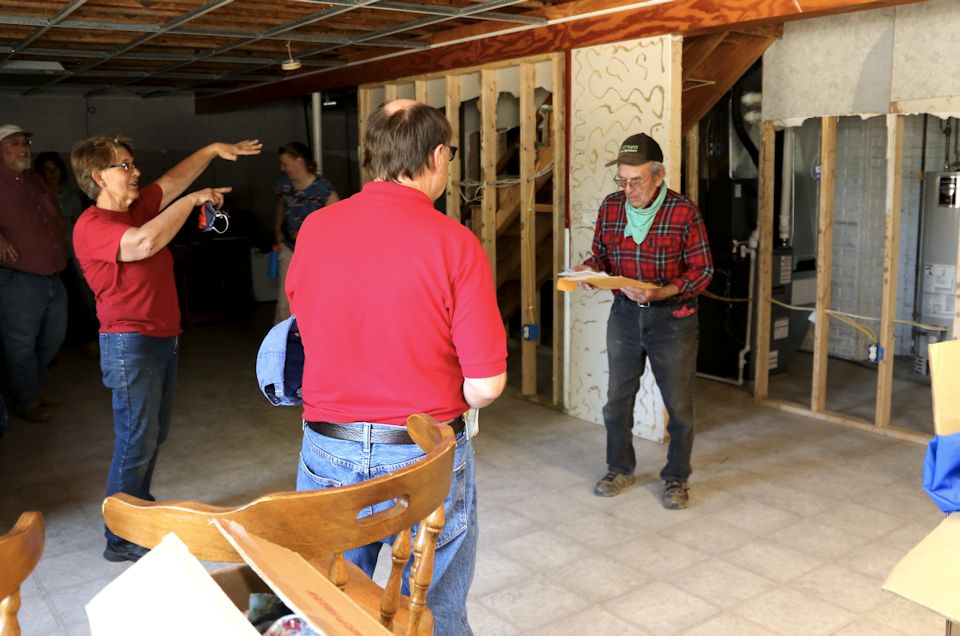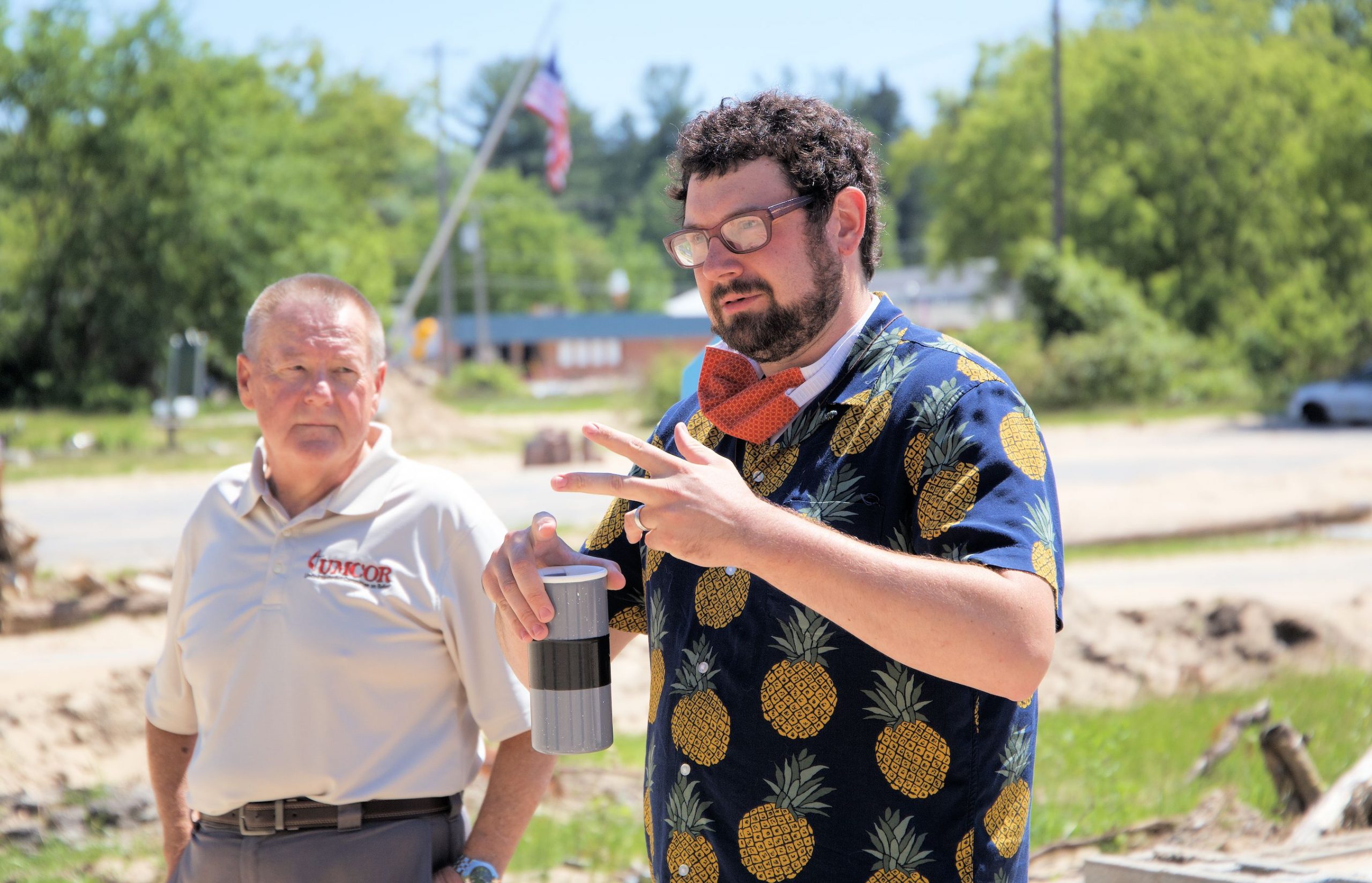Many, many more weeks of relief and recovery are ahead in mid-Michigan after May 19th flooding caused significant damage in over 1000 households across five counties. Here’s an eye-witness account.
MARK DOYAL
Director of Communications, Michigan Conference
June 16, 2020 | SANFORD, Michigan — As Bishop David Bard walked on what remained of Saginaw Street entering Sanford, Michigan, he looked in awe at the complete and utter devastation in every direction. “Most of us have a picture in our mind of what flooding looks like,” he said. “The water rises up and stays a while before receding. But this looks more like the damage from a massive tornado than a flood.”
Bicycles and bathtubs tangled in trees. Crushed cars and roads flipped upside down like pancakes. Pipes and cement slabs, the only remaining signs of where family homes once stood. It has been nearly one month since heavy rains, and the failure of two dams resulted in catastrophic flooding in the Great Lakes Bay Region.

Looking at a map of the area, it is not hard to understand how heavy rains, added to the two drained lakes from failed dams, funneled down the Tittabawassee River, creating a massive wall of water that washed out entire communities in minutes the evening of May 19th. The waters continued their rampage and destroyed hundreds of homes, displacing thousands of people. Miraculously, no one was killed.
On Tuesday, Bishop Bard toured the region accompanied by Central Bay District Superintendent John Kasper. They gained a clearer understanding of the damage from Michigan Conference Coordinator of Disaster Response Ministries, Nancy Money, and Disaster Response Coordinator, Dan O’Malley. Money has been working with federal, state, and local agencies to coordinate the long-term recovery of the region since the night the flooding occurred. O’Malley has been her partner in the effort, coordinating volunteer response and Early Response Teams (ERTs).

At Sanford United Methodist Church, Pastor Lisa Cook described how flooding from heavy rains and river run-off, damaged the parsonage and office areas in the lower level of the church. Cook, who retires this July, thankfully had been downsizing life to fit inside a retirement RV.
When the order to evacuate came, she and her husband were able to quickly pack up their possessions in the RV and join hundreds of vehicles streaming out of town. Other members of her congregation were not so fortunate, experiencing serious property damage, including the owner of the local hardware store, which was almost completely destroyed.

United Methodist churches in nearby communities quickly mobilized to offer support to the many towns in the path of the flood. Pastor Scott Marsh and the congregation of Faith United Methodist Church in Coleman, about 10 miles northwest of Sanford, assisted homeowners in removing debris and muck outs. Marsh described coming upon 40-foot trees, stump still attached, thrown against homes. “The force of the water was unimaginable,” he said, “everything in its path was swept away.” The congregation of Freeland UMC, led by Pastor Kayla Roosa, distributed free cleaning kits from the front lawn of the church to those who were affected more than 20 miles downstream. “People have been generous and giving,” she said. “It has been beautiful watching people respond so generously in the middle of so much chaos.”

Today, life is difficult for those hit by the floodwaters, particularly in smaller communities outside of the media spotlight. The waters receded, leaving behind mud, sand, silt, and with it piles of financial and emotional debris. Bishop Bard lamented, “You know behind every damaged store-front and home no longer there, are people’s lives. Homes and businesses, they’ve put their hearts and souls into, now totally gone.”
Many are still unable to return home, awaiting replies from insurance companies and government agencies. This is where the Michigan Conference is working with community organizations for the long-term recovery that will be necessary to bring the area back to a new normal. “It’s a hard time,” said Nancy Money. She added, “Those affected want immediate relief, but it’s so important not to move too quickly and miss out on all the support that will come with time.” This is particularly the case for those who did not have flood insurance. “They are on their own to figure out how to get on with their lives,” Dan O’Malley told the bishop. “For those already struggling financially, it’s devastating,” O’Malley observed.

The Central Bay District parsonage was among those homes impacted. Incoming District Superintendent John Kasper expressed his profound thanks for the district volunteers from local churches who are helping to repair his house before his arrival in July. Kasper is also grateful for the generous spirit helping the entire Great Lakes Bay Region.
Before departing Sanford, Bishop Bard led the group to the middle of a now-empty crossroad in town and said, “We pray, O God, that you would give us grace and strength to be a healing presence in this community and other communities affected by this flood. May the compassion you helped well up in our hearts, well up in the hearts of others, so that in the midst of so many things going on in our world, this pain and this grief not be forgotten, that we can, in the name and Spirit of Jesus, be healers. May it be so. In Jesus’ name, we pray, Amen.”

What are the ways that prayers and compassion may translate into direct aid to the Great Lakes Bay Region? At present, the Federal Emergency Management Agency (FEMA) estimates that 907 households suffered significant flood damage. Hundreds are left homeless at this time. These residents live in a five-county region, over half in Midland County.
Needs assessment continues. Grants from The United Methodist Committee on Relief (UMCOR) and Midland Area Community Foundation are anticipated. This funding will support long-term recovery, expected to get underway two months from now.
What’s needed most is dollars. Checks may be sent to the Michigan Conference at 1161 East Clark Road, Suite 212, DeWitt MI 48820. It is important to include this exact language in the memo: #4407 Michigan Area Disaster Response. Give online here.

United Way of Midland County is currently organizing volunteer efforts. Those with time and helping hands may contact them to learn more about when and where help is needed now.
The Michigan Conference is engaged in preparedness for the long haul, mustering supplies and volunteer labor that will be needed to support the recovery phase. Repairs and rebuilds are expected to take 18-24 months to complete. Those who wish to partner with the work ahead are asked to fill out the Long-Term Recovery Survey. Updates –calls for labor, materials, and funds — will be communicated to individuals based on their responses. Click here to participate in the survey.
Please note that Cleaning Kits are not a priority at this time. Kits already assembled may be delivered to drop-off sites listed here.

The scale and scope of devastation stretching from Sanford to Freeland are beyond belief. The village of Sanford has been rendered a virtual ghost town. United Methodists were on the scene in the early hours of the disaster and will remain on the scene until lives are restored. Your generous gifts can help transform the landscape, both physical and spiritual, with hammers and with hope.
Last Updated on November 1, 2023

